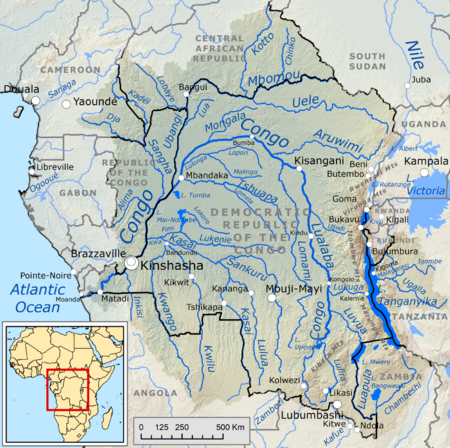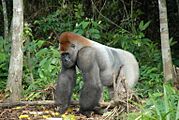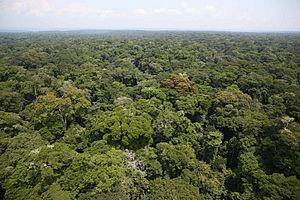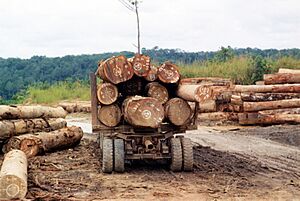Congo Basin facts for kids
The Congo Basin (also called Bassin du Congo in French) is a huge area of land drained by the Congo River. It is located in Central Africa, near the equator. This region is sometimes simply called the Congo. It is home to some of the world's largest tropical rainforests. It also provides a lot of water for farming and making energy.
The rainforest in the Congo Basin is the biggest in Africa. It is the second largest rainforest in the world, after the Amazon rainforest. It covers about 300 million hectares. This huge forest helps fight climate change by soaking up carbon dioxide from the air. However, cutting down trees and the effects of climate change are harming the forest. This can make the water levels in the basin change a lot. A study in 2012 found that changes in rainfall due to climate change will hurt the economy in the basin.
Eight places in the Congo Basin are special World Heritage Sites. Five of these are also on the list of sites in danger, all in the Democratic Republic of the Congo. About 14% of the humid forest is protected.
Contents
What is the Congo Basin?
The Congo Basin is a large, bowl-shaped area in the middle of Africa. It is a huge dip in the Earth's surface. This basin is filled with younger rocks, while the land around it is made of very old rocks. Over millions of years, sediments (like sand and mud) have built up in this basin.
Long ago, there were freshwater lakes in the basin. Later, the ocean briefly flowed into the basin. These ancient environments left behind many fossils of plants and animals. The region is also famous for its diamonds. These diamonds formed deep in the Earth and came to the surface through special rock pipes.
Where is the Congo Basin?
The Congo Basin is a traditional name for the middle part of equatorial Africa. It stretches between the Gulf of Guinea and the African Great Lakes. The Congo River starts in the highlands of the East African Rift system. Many rivers, like the Chambeshi, Uele, and Ubangi, feed into it. The Lualaba River drains large wetlands in the middle of the basin.
The basin ends where the Congo River flows into the Atlantic Ocean. The total area of the basin is about 3.7 million square kilometers. It holds some of the largest untouched tropical rainforests and huge wetlands on Earth.
Here are the countries that are fully or partly in the Congo Basin region:
History of the Congo Basin
The first people to live in the Congo Basin were likely Pygmies. The thick forests and wet climate meant there were not many people. They lived as hunter-gatherers. Later, Bantu peoples moved into the area and formed kingdoms, like the Kingdom of Kongo.
By the late 1800s, Belgium, France, and Portugal took control of the entire region. An agreement in 1885, called the Berlin Conference, set the exact borders of the "conventional basin" of the Congo. This agreement said the area should be neutral, but this was not followed during World War I.
Today, about 80 million people live in and around the Congo Basin.
Climate in the Congo Basin
The Congo Basin is very important for the world's climate. It gets a lot of rain, usually between 1500 and 2000 millimeters each year. It is one of the three main places in the tropics where big thunderstorms form. These storms help drive the world's weather patterns. The Congo Basin also has the most lightning strikes on the planet! This high rainfall helps support the second largest rainforest on Earth. This forest is a huge "carbon sink," meaning it takes in a lot of carbon dioxide.
The basin usually has two main rainy seasons: from March to May and from September to November. Temperatures in the Congo Basin are usually between 20 and 30 degrees Celsius. This is cooler than the deserts to the north (The Sahara) and south (Kalahari). These temperature differences help create winds that affect the climate in other parts of Africa.
Scientists believe the region will get hotter because of global climate change. It is not clear how much the average rainfall will change. However, it is likely that very heavy rain events will become even stronger. Because the Congo Basin is so important for the global climate, big changes here could have a huge impact on the Earth's weather systems.
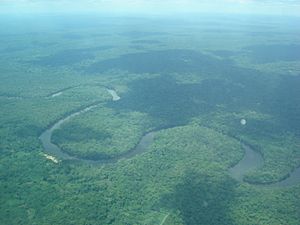
Animals and Plants
The Congo forest is home to many unique animals. These include the okapi, African forest elephant, pygmy hippopotamus, bongo (antelope), chimpanzee, bonobo, and the Congo peafowl. The main hunter here is the Leopard. The basin is also home to the endangered western lowland gorilla. In 2010, the United Nations warned that gorillas could disappear from the Congo Basin in about 15 years.
The Congo Basin is Africa's largest forest. More than 10,000 types of plants grow here. The humid forests cover 1.6 million square kilometers. The Congo Basin is also an important source of African teak, a type of wood used for furniture and flooring. About 40 million people depend on these forests for their traditional ways of life.
Protecting the Congo Basin
The forests of the Congo Basin are like the planet's second "lung," after the Amazon. They are a huge "carbon sink," meaning they store a lot of carbon. If these forests are cut down, the carbon they hold will be released into the air as carbon dioxide. Some predictions suggest that if deforestation continues, the amount of carbon released by 2050 could be huge.
However, a 2013 study showed that deforestation in the Congo Basin rainforest was slowing down. In 2017, scientists found huge peatlands (wetlands with lots of decaying plants) in the Cuvette Centrale. These peatlands cover a large area and hold an enormous amount of carbon. But in 2021, the rate of deforestation in the Congolese rainforest increased by 5%.
The logging industry affects a vast area of forest. A study in 2019 showed that many miles of roads were built for logging between 2003 and 2018. In 2002, the World Bank and the Democratic Republic of the Congo agreed to stop new logging permits. The World Bank offered money to the DRC if the government did not allow new logging.
The government has a new forestry rule. It says that logging companies must invest in local communities and follow a plan for sustainable logging. When a company gets permission to log, it must make an agreement with local leaders. In return for cutting trees, the company is supposed to help develop the local area. Companies are also supposed to pay rent to the government, and part of this money should go back to local areas for social projects.
There is a hope that protecting forests will become a way for countries to earn money, as part of global efforts to fight climate change. For example, L’Île Mbiye, an island in the Lualaba River, is part of a project to save the forest ecosystem. The Democratic Republic of the Congo also wants to protect more forest areas. They hope to get paid for this through new markets for forest carbon. A local group called OCEAN works with international groups like Greenpeace to help protect the forests and support local communities.
National Parks
Many important national parks protect parts of the Congo Basin:
- Lobéké National Park
- Lomami National Park
- Nouabalé-Ndoki National Park
- Ntokou-Pikounda National Park
- Odzala-Kokoua National Park
- Salonga National Park
- Virunga National Park
- Garamba National Park
- Kundelungu National Park
- Kahuzi-Biega National Park
- Upemba National Park
- Maiko National Park
See also
 In Spanish: Cuenca del Congo para niños
In Spanish: Cuenca del Congo para niños


